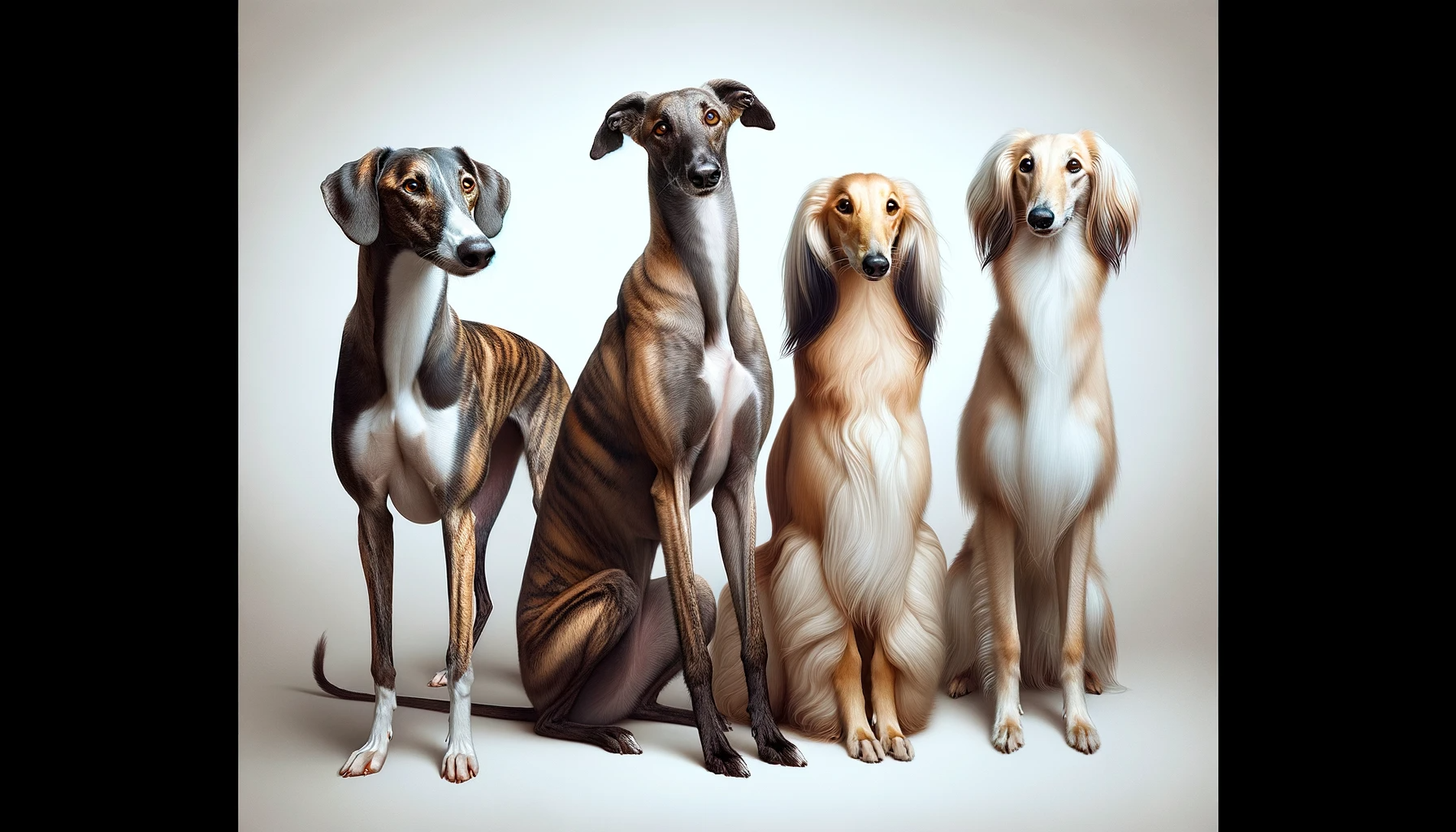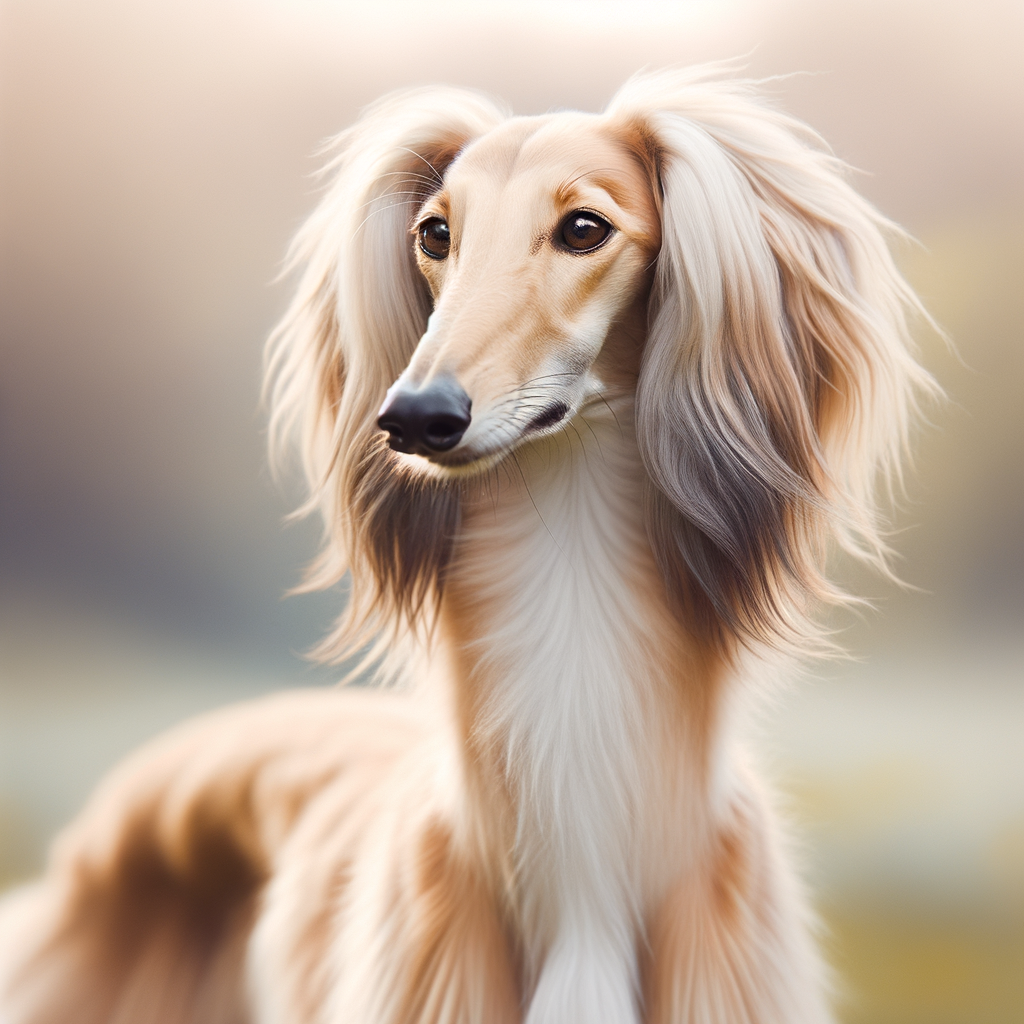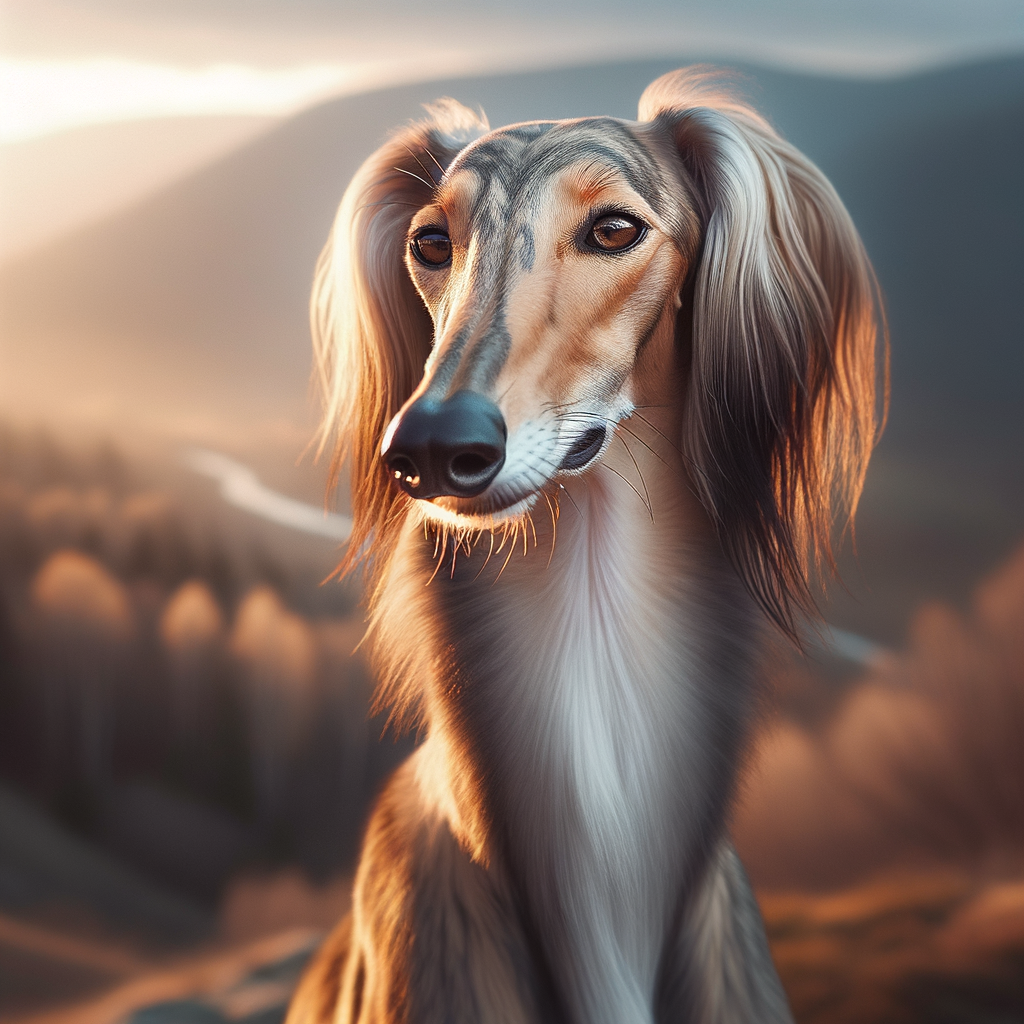When it comes to our beloved four-legged friends, we’re often captivated by their physical traits and wonder how they got them. One such intriguing characteristic is the elongated head seen in certain dolichocephalic dog breeds. Ever noticed how certain dogs like the Greyhound or Saluki have long, narrow skulls, almost like an aerodynamic design? Well, that’s precisely what ‘dolichocephalic’ refers to.

Understanding the traits of dolichocephalic dogs is important for several reasons. Firstly, it can unveil a wealth of information about their physical abilities, behavioral tendencies, and potential health issues. For instance, their long noses often grant them superior scent-tracking abilities, making them excellent hunting and search dogs. On the flip side, these breeds might be more prone to dental issues due to the structure of their jaws.
Moreover, recognizing the significance of dolichocephalic traits can help you make informed decisions if you’re considering adopting one of these breeds. You’ll be better equipped to provide proper care, handle their unique grooming needs, and understand their dietary needs. Plus, you’ll have a keen insight into their potential capabilities in sports or work scenarios, like racing or hunting.
So, if you’ve been intrigued by these long-headed canines and want to understand what makes them tick, you’re in the right place. Let’s dive in and explore the fascinating world of dolichocephalic dog breeds!

Ever wondered why certain dog breeds have longer heads than others? The answer lies in their evolutionary background, a fascinating story that intertwines nature, nurture, and the intricate relationship amongst breeds. As we delve into the origins and adaptations of dolichocephalic dogs, you’ll learn to appreciate these unique canines even more. So, let’s embark on this thrilling journey!
Historical Significance of Dolichocephalic Breeds
The term “dolichocephalic” translates to “long head”. It’s a shape that has deep roots in the canine world’s history, serving practical purposes for different breeds. From ancient royalty to medieval hunters, dolichocephalic dogs have been treasured for centuries.
Greyhounds and Salukis, for instance, were esteemed members of the Pharaohs’ royal courts in ancient Egypt. Sight hounds with their long, streamlined heads were prized for their speed and agility. Moving forward in history, Bloodhounds and Afghan Hounds showcased their scent-tracking prowess, their elongated muzzles packed with millions of scent receptors, ideal for tracking game or missing persons.
Adaptations and Functions of the Long Head Shape
Now, you might ask, “Why the long face?” Well, it’s not just about appearances. The elongated head shape of dolichocephalic dogs offers evolutionary advantages that boost their survival and performance.
For sight hounds, their long heads and narrow bodies minimize air resistance, enabling them to reach incredible speeds. Greyhounds, Whippets, and Salukis top the list of the world’s fastest dogs, thanks to their aerodynamic structure. Their elongated skulls also house large, wide-set eyes that provide a broader field of vision, enhancing their ability to spot and chase prey.
For scent hounds like Bloodhounds, Afghan Hounds, and Borzois, their long noses contain more olfactory cells. This means these breeds can detect scents that other breeds might miss. In fact, a Bloodhound’s sense of smell is so accurate it can even be used as evidence in court!
However, it’s not only the hunting and racing dogs that benefit from a long head shape. Breeds such as the Dachshund, originally bred for badger hunting, have their unique head shape to help maneuver in tight burrows. Similarly, Collies and Shelties, bred for herding, have narrow heads that allow for nimble navigation through flocks of sheep.
In each of these examples, we see how the dolichocephalic head shape has been naturally and selectively bred for specific tasks. Yet, whether they’re chasing a hare, sniffing out a trail, or herding sheep, all of these breeds share the same charm and elegance that captivate us today.
Understanding the evolutionary background of these long-faced beauties gives you a new perspective on why your dog looks and behaves the way it does. It’s a testament to the incredible diversity within the dog world, a diversity driven by the specific needs and roles each breed was developed to fulfill. So, next time you look at your dolichocephalic dog, you’ll see not just a faithful friend, but a remarkable product of evolution.
Dolichocephalic Dog Breeds: A Comprehensive List
When it comes to dogs, diversity is the name of the game. From round-faced Pugs to square-jawed Bulldogs, the canine family boasts a variety of species with unique physical characteristics. Among them, dolichocephalic dog breeds stand out for their elongated heads. These breeds have a rich history, and include both sight hounds and scent hounds. Each breed has its own set of characteristics, making them unique in their own way.
Sight Hounds: Greyhounds, Whippets, and Salukis
Sight hounds are a group of breeds known for their exceptional vision and remarkable speed. With their slim body build and long, narrow heads, they are built for high-speed pursuit. Let’s take a look at some popular sight hounds:
– Greyhounds: Known as the “Cheetahs of the Dog World”, Greyhounds are incredibly fast runners. They were originally bred for hunting game, but today they often steal the show at dog racing events. With their long heads and slender bodies, they are the epitome of dolichocephalic breeds.
– Whippets: Whippets are often referred to as “miniature Greyhounds” due to their similar physical characteristics and temperament. They are one of the fastest breeds, capable of reaching speeds up to 35 mph. Like Greyhounds, they have elongated heads and slim bodies.
– Salukis: Another sight hound, the Saluki has an extend head and a swift, graceful stride. Originating in the Middle East, they were used to hunt gazelle and other fast prey. Salukis have a quiet, gentle temperament and are known for their loyalty.
Scent Hounds: Bloodhounds, Borzois, and Afghan Hounds
Scent hounds, as the name suggests, are breeds with an exceptional ability to track scents. They have a long history of being used for hunting due to their keen sense of smell. Their dolichocephalic characteristics aid in their scent tracking abilities. Here are a few scent hounds:
– Bloodhounds: Famous for their extraordinary sense of smell, Bloodhounds have been used for centuries in search and rescue operations. They have a distinctive long head and droopy ears, which help to trap and hold scents.
– Borzois: Originally bred in Russia for hunting wolves, Borzois are elegant and aristocratic. Their long heads and snouts are characteristic of dolichocephalic breeds, fitting for a dog breed that relies heavily on its sense of smell.
– Afghan Hounds: With their exotic appearance and long, silky hair, Afghan Hounds are one of the most recognizable dolichocephalic breeds. Originating in Afghanistan, these dogs were bred to hunt in the rough mountainous terrain, using their keen sight and sense of smell.
With their distinctive long heads, dolichocephalic dog breeds are not only unique in appearance, but also in their abilities. Whether they’re chasing after a lure on a race track or tracking a missing person, these breeds excel in tasks that require speed, agility, and a keen sense of smell. This comprehensive list of dolichocephalic breeds showcases the diversity within the canine family and the incredible adaptations these breeds have undergone over centuries.
Physical Health Considerations for Dolichocephalic Breeds
Common Health Issues in Long-Headed Dogs
Although dolichocephalic dog breeds are known for their unique, elongated heads, this distinct trait may also make them prone to certain health issues. While every breed has its unique health concerns, dolichocephalic breeds are particularly susceptible to certain conditions due to their head shape:
– Oral Health Issues: The long, narrow skulls of these breeds often mean a crowded mouth, which can lead to dental issues such as periodontal disease and tooth decay.
– Eye problems: Dolichocephalic dogs may have issues related to their eyes due to the shape of their skull. These can include corneal ulcers, retinal detachment, and glaucoma.
– Respiratory Problems: These breeds often have elongated soft palates and narrow nasal passages, which may lead to brachycephalic syndrome, a condition resulting in breathing difficulties.
Knowing these potential issues can help pet parents monitor their dogs and seek veterinary care when necessary.
Veterinary Care and Preventitive Measures
As a dog parent, you can take proactive measures to ensure the health of your dolichocephalic dog. Regular veterinary check-ups are crucial for early detection and treatment of potential health issues. Here are some specific preventative measures to consider:
– Dental Care: Consistent oral hygiene, including regular brushing and dental check-ups, can help prevent the development of dental issues.
– Eye Care: Regular home eye examinations and immediate veterinary consultation at the first sign of an eye issue can be critical in preventing vision loss.
– Weight Management: Maintaining a healthy weight is especially important for dolichocephalic breeds, as excess weight can exacerbate breathing difficulties.
To conclude, while dolichocephalic dog breeds are known for their distinct long heads, this trait can also bring along specific health considerations. However, with early detection and preventative care, these dogs can live healthy, happy lives.

Behavioral Traits and Temperament of Dolichocephalic Dogs
Understanding the behavioral traits and temperament of dolichocephalic dogs is crucial for potential owners. These long-headed breeds often have distinct personalities and behavioral tendencies that set them apart from other dogs.
Personality Differences Among Long-Headed Breeds
Dolichocephalic dog breeds are as diverse in personality as they are in appearance. Here are a few common traits:
- Highly Focused: Dogs with longer skulls, like Greyhounds and Whippets, are often highly focused and have a strong prey drive. This is because their elongated skulls allow for a more concentrated field of vision, making them excellent hunters.
- Intelligent: Many dolichocephalic breeds are known for their intelligence. For instance, the Afghan Hound, despite its aloof demeanor, is incredibly smart and capable of independent thought.
- Sensitive: Dolichocephalic dogs tend to be more sensitive than other breeds. They can be easily startled by loud noises or sudden movements, and they often form strong emotional bonds with their owners.
However, it’s important to remember that every dog is an individual. While these traits may be common among dolichocephalic breeds, they don’t apply to every long-headed dog.
Training and Socialization Tips for Dolichocephalic Canines
Training a dolichocephalic dog can be a unique experience. Their intelligence and focus can make them quick learners, but their sensitivity may require a gentle approach. Here are a few tips:
- Positive Reinforcement: Dolichocephalic dogs respond well to positive reinforcement. Rewarding good behavior with treats, praise, or playtime can be very effective.
- Early Socialization: Socializing your dog at a young age can help them become more comfortable around other dogs and people. This can be especially important for dolichocephalic breeds, as they can sometimes be wary of strangers.
- Consistent Training: Consistency is key when training any dog, but especially so with dolichocephalic breeds. Their intelligence means they can pick up on inconsistencies in your training, which may confuse them.
In conclusion, dolichocephalic dogs are a unique group with distinct behavioral traits and temperaments. Understanding these characteristics can help you provide the best care for your long-headed friend. Whether you’re considering adopting a dolichocephalic breed or already share your home with one, remember that every dog is unique, and understanding their individual personality is just as important as understanding their breed traits.
Dolichocephalic Dogs in Competitive Sports and Work
When you think of a dolichocephalic dog, the image that first pops into your head is likely of a sleek, fast-running hound. And indeed, many dolichocephalic breeds excel in various competitive sports and work roles. To better understand their roles, let’s delve into the fascinating world of these long-headed canines.
The Role of Dolichocephalic Breeds in Racing and Hunting
First off, let’s talk about racing. Dolichocephalic breeds like the Greyhound and Whippet are literally built for speed. These dogs have a unique combination of a large heart, lean body, and long limbs, all of which contributes to their exceptional speed. When you see one of these dogs in action on the racetrack, you can’t help but marvel at their grace and power.
But it’s not all about the race. Dolichocephalic breeds are also keen hunters. Their long heads and noses provide them with an enhanced sense of smell and vision, which are both crucial for tracking down prey. For example, Bloodhounds are known for their impeccable scent-tracking abilities, often used by law enforcement to track missing persons. Afghan Hounds, on the other hand, were initially bred for hunting large prey in the rough terrains of Afghanistan.
Success Stories of Long-Headed Dogs in Various Canine Sports
So, what’s the real-world impact of these dolichocephalic dogs’ abilities? Let’s share a few success stories.
- Ginger, the Whippet: In the world of canine sports, Ginger is a superstar. This Whippet has won multiple national and international titles in lure coursing, a sport designed to simulate the chase of prey.
- Duke, the Bloodhound: Duke is a hero in his own right. As a search and rescue dog, he has helped find numerous missing persons, thanks in part to his exceptional scent-tracking skills.
- Lulu, the Borzoi: Lulu is a wonder in the show ring. Her graceful gait and stunning appearance have won her many accolades in dog shows across the country.
These are just a few examples of dolichocephalic dogs making a name for themselves in various fields. Whether they’re speeding down a racetrack, tracking a scent, or strutting in a show ring, these dogs showcase the impressive capabilities of their breed.
From their unique characteristics to their incredible skills, dolichocephalic dog breeds offer a world of fascination. Whether you’re a dog lover, a prospective pet owner, or just someone with a curiosity about dogs, these long-headed canines are sure to capture your interest and admiration.

Grooming and Maintenance for Long-Headed Dog Breeds
As a loving owner of a dolichocephalic dog breed, it’s crucial to understand the grooming and maintenance needs that are specific to your pet. These breeds have unique features that require a little extra care to keep them healthy and comfortable.
Grooming Needs Specific to Dolichocephalic Dogs
With their long heads and narrow muzzles, dolichocephalic dogs can face certain grooming challenges. Let’s dive into some of these needs:
- Ears: Dogs like Greyhounds, Salukis, and Afghan Hounds have large, floppy ears that can be prone to infections. Regular cleaning with a vet-approved solution can help keep your dog’s ears healthy.
- Eyes: Some long-headed breeds have more exposed eyes, making them more susceptible to injuries and infections. Regularly checking and gently cleaning your dog’s eyes can help prevent issues.
- Teeth: Dolichocephalic dogs often have overcrowded and misaligned teeth due to their narrow muzzles, making them more prone to dental disease. Regular brushing and professional dental cleanings are crucial.
- Coat: Many dolichocephalic breeds, such as Afghan Hounds and Borzois, have long, silky coats that require regular brushing to prevent mats and tangles.
Diet and Exercise Regimens for Optimal Health
In addition to grooming, your long-skulled furry friend needs a well-balanced diet and regular exercise to maintain optimal health.
- Diet: The diet of dolichocephalic breeds should be high in quality protein and balanced with healthy fats and carbohydrates. As these dogs can be prone to bloating, smaller, more frequent meals may be beneficial. Always consult your vet about the most suitable diet for your dog.
- Exercise: Dolichocephalic breeds are typically energetic and athletic. Regular exercise is essential to keep them physically fit and mentally stimulated. Depending on the breed, this could be anything from daily walks to high-intensity agility training.
Caring for a dolichocephalic dog breed can be a rewarding experience. With their unique traits and charming personalities, these dogs can bring so much joy to our lives. Understanding their specific grooming and maintenance needs is just one way you can ensure your long-headed canine friend stays happy and healthy. As always, it’s best to consult with your vet for any specific health or grooming concerns.
Adopting a Dolichocephalic Dog: What Prospective Owners Should Know
Deciding to bring a dolichocephalic dog, or a long-headed canine, into your home is an exciting decision. These unique breeds, with their elongated heads and specific traits, have a charm all their own. However, there are several factors you should consider before adoption.
Considerations Before Bringing a Long-Headed Dog Home
Before you fall in love with a dolichocephalic breed, it’s important to understand what it truly means to care for one. Here are some key considerations:
- Breed Characteristics: These breeds have a unique set of characteristics, from their strong sense of smell to their speed. Understanding their innate traits will help you provide a suitable environment for them.
- Health Concerns: Dolichocephalic dogs are more prone to certain health issues like Brachycephalic Airway Obstruction Syndrome (BAOS), dental overcrowding, and eye problems due to their head shape. Regular veterinary check-ups and preventive care are crucial.
- Nutrition and Exercise: These breeds often require a balanced diet and a specific exercise regimen to keep them at optimal health. Make sure you can provide this.
- Grooming: Depending on the breed, some dolichocephalic dogs may require regular grooming. If you’re looking at a breed with a thick coat, like an Afghan Hound, be prepared for this commitment.
As a potential dog parent, it’s your responsibility to factor in all these considerations to ensure that you can provide a loving and caring home for your dolichocephalic dog.
Resources and Support for Dolichocephalic Dog Owners
Thankfully, you don’t have to navigate this journey alone. There are several resources available to help you care for your long-headed canine:
- Breed Specific Clubs: Joining breed-specific clubs can provide you with invaluable insights and support from other owners of the same breed.
- Online Forums: There are several online forums where you can connect with other dolichocephalic dog owners, ask questions, and share experiences.
- Veterinary Advice: Regular consultation with your vet can help prevent potential health issues and ensure your dog lives a healthy, happy life.
- Training Classes: Dolichocephalic dogs can benefit from training classes that cater to their specific temperaments and needs.
Adopting a dolichocephalic dog can be a rewarding experience, but it’s essential to go into it with your eyes wide open. These breeds with elongated heads require specific care and attention, but with the right preparation and resources, you can provide them with a loving home they deserve.
The journey with your long-headed canine will undoubtedly have its challenges, but it will also be filled with unique experiences and moments of joy. After all, these breeds, from the swift Greyhound to the majestic Afghan Hound, have charmed humans for centuries with their distinct traits.
With the right knowledge and commitment, you’ll soon find that adopting a dolichocephalic dog isn’t just about bringing a pet into your home – it’s about welcoming a new family member who will bring endless love and happiness into your life.
Frequently Asked Questions
1. What does Dolichocephalic mean in dogs?
Dolichocephalic refers to dogs that have a longer skull compared to its width. This term is used to describe certain breeds of dogs that have a distinct long-headed shape.
2. What are some examples of Dolichocephalic dog breeds?
Some examples of Dolichocephalic dog breeds include the Greyhound, Afghan Hound, Dachshund, and the Irish Wolfhound. These breeds are known for their elongated heads.
3. Are there any health issues associated with Dolichocephalic dog breeds?
Yes, Dolichocephalic dog breeds can be prone to certain health issues due to their unique skull shape. These can include dental problems, eye issues, and breathing difficulties.
4. How does the skull shape affect the behavior of Dolichocephalic dogs?
The skull shape of Dolichocephalic dogs can influence their behavior. These dogs often have a strong prey drive and are known for their speed and agility. Their long noses also give them an excellent sense of smell.
5. How should I care for a Dolichocephalic dog breed?
Caring for a Dolichocephalic dog breed involves regular vet check-ups to monitor for any potential health issues. It’s also important to provide them with plenty of exercise to satisfy their high energy levels.
Dr. Candy, a holistic veterinarian and certified raw dog food nutrition specialist, graduated from Oklahoma State University in 2009 with a DVM and has since specialized in companion animal nutrition, advocating for species-specific diets. With a background in wildlife rehabilitation and oil spill response, she combines holistic health and conventional medicine in her unique approach to treating chronic diseases, allergies, and autoimmune conditions in pets. As the owner of a veterinary practice in Colorado and an author, Dr. Candy is dedicated to educating pet parents and improving the health and happiness of animals.




